Five really good Japanese Christmas movies
Peter Breedveld
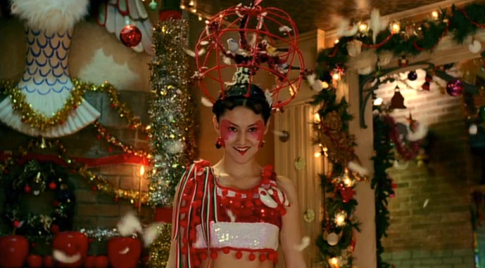
Scene from Survive Style 5+
Christmas in Japan, for most Japanese, is not about Baby Jesus (about one percent of the total Japanese population is Christian) or family dinners. Christmas is more a romantic thing and if there is a Japanese Christmas tradition, it’s splurging on fried chicken at… KFC’s.
Japanese, however, never let an opportunity go by to decorate their public spaces as prettily as possible, so around Christmas there are Christmas lights and lit up trees everywhere and Christmas music is playing in the bars and restaurants and shops. There’s really no reason to avoid Japan around Christmas if you’re a Christmas enthousiast. In fact, last year I was walking around Yokohama, it was April, already really hot, the sun was blazing, when I came across a small shop, with a Santa Claus in front and a Christmas wreath on the front door and everything, and it was a shop filled from floor to ceiling with Christmas stuff, with flickering lights and moving gadgets and loud Christmas music playing. It was surreal. Here is a photo of the interior.

Christmas movies, however, are not a big thing in Japan. In fact, I can’t remember Christmas even being referred to Japanese movies from before, say, the late eighties. I have the impression Christmas only became popular in Japan at the time of the economic bubble, when the whole world became obsessed with Japan. But I could be wrong.
There are some Japanese Christmas movies and a handful of them are even pretty damn good. With the right atmosphere, the right looks and a genuine Christmas message of love and forgiving, even if the makers are sometimes taking the piss with it.
Anyway, here are my five favorite Japanese Christmas movies, for if you’d like to see something a little different from White Christmas and Love Actually.
5: Until the lights come back (Daiteiden no yoru ni, 2005)
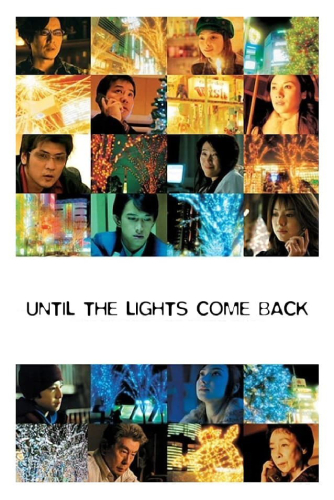
This movie by director Minamoto Takashi is clearly inspired by the huge success of the British Christmas movie Love Actually, which came out two years earlier, but the influence of Paul Thomas Anderson breakthrough movie Magnolia (1999) is also obvious. I think Minamoto decided to make a Japanese Love Actually (or probably was commissioned to), but more in the vein of Magnolia.
Until the Lights Come Back is not nearly as good as Magnolia, in fact, Minamoto made a much better movie (in the same year!) with intertwining storylines, Tokyo Tower. Until the Lights come Back lacks the humour of Love Actually, but I have watched it twice now, while I have never been able to finish Love Actually, so that must say something (about me, probably).
It’s about the lives of several Tokyoites whose paths cross on Christmas Eve, during a huge power failure, caused by what seems to be a meteorite. At that moment a young boy meets a suicidal woman, a man is looking for the woman he just recently learned is his real mother, a Chinese hotel employee gets trapped in the elevator with a heartbroken woman, another woman is stuck in the metro, about to give birth and the owner of a jazz cafe meets with the woman who owns a candle shop opposite his cafe.
The power failure, of course, serves as a catalyst in the lives of these people who become closer to each other, arrive at some stage of self-realisation or help someone getting across some point in their life. Nothing earth-shocking, but warm-hearted and charming and really very beautifully filmed and full of Christmas lights and decorations and everything. It is a little heavy-handed, a tad too long and it’s a shame Minamoto doesn’t make better use of actress Terajima Shinobu, who is one of the best actresses in Japan today. She plays the rather passive part of the pregnant woman (who is saved by an altruïstic man). Happily, Minamoto got to use her again in Tokyo Tower, in which she has a much more interesting part.
Unfortunatey it seems impossible for us to see the film legally, because the English subtitled blu-ray appears to be sold out. There is a Korean DVD with Japanese audio and Korean and English subtitles on eBay and the Japanese DVD is of course available on Amazon.co.jp.
4: Tokyo Godfathers (Tōkyō Goddofāzāzu, 2003)
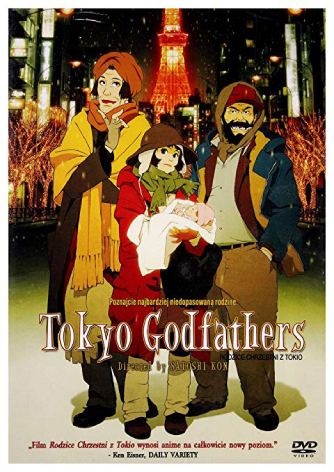
I think this Christmas movie is the best known outside of Japan. It is an animated movie by Kon Satoshi about three homeless people who find a baby on Christmas Eve and decide not to bring it to the police but raise it themselves. Based on John Ford’s famous western Three Godfathers (with John Wayne) or the French movie Trois Hommes et un Couffin or the book both those movies are based on, I forget.
As is pointed out on the excellent Japanese movie blog Midnight Eye, Tokyo Godfathers is rather problematic in its gender politics. One of the homeless is a trans woman who seems to see the baby as a surrogate for the love she never got from her parents, at the end of the movie things get really tense when a hysterical young woman kidnaps the baby and endangers its life and the moral of the story is that a child is really better off being raised by its biological parents.
But hey, White Christmas has a blackface scene, and that never hindered it to become, and stay, the ultimate Christmas classic.
Tokyo Godfathers is a very entertaining movie, warm-hearted, funny, touching and a social commentary on how Japan treats its outcasts. It seems to be a very realistic portrait of the life of homeless people.
But the best thing is the way Tokyo is portrayed in this movie. As Midnight Eye observes: ’the movie’s urban atmosphere almost becomes a character in itself’. The snowy streets and alleys look gorgeous and contribute to the wonderful atmosphere.
Available on DVD and Blu-ray all over the place.
3: Hold Up Down (Hôrudo Appu Daun, 2005)
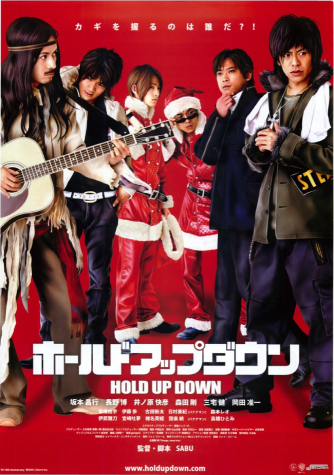
This is a typical movie for director Sabu, known for his ballistic and absurdist low budget action flicks. In Hold Up Down two guys in Santa suits rob a bank, only to find out their car is being towed away for illegal parking. They stash their loot in a locker in a mall after robbing a street musician for the coins needed to use the locker. The musician gives chase, but the robbers escape, losing the key to the locker, which is found by the musician. He gets hit by a police car, accidentily swallows the key, ends up in the river, is dragged out of it by a religious truck-driver who mistakes him for his lord and saviour Jesus Christ, and what follows is a kind of road movie in which the robbers, the police, the truck driver and the frozen body of the street musician are on each others tails.
Everyone ends up in a spa hotel and a lengthy hommage to Stanley Kubrick’s The Shining ensues, but with Jacky Chan like karate fights. It’s totally idiotic and entertaining. Probably not for everyone, but certainly one of the most fun Christmas movies I ever saw.
Legally watching this movie is rather hard for us here outside of Japan. There is a DVD with English subs, but it’s not cheap. I can’t even find the trailer. So here’s a picture from it:
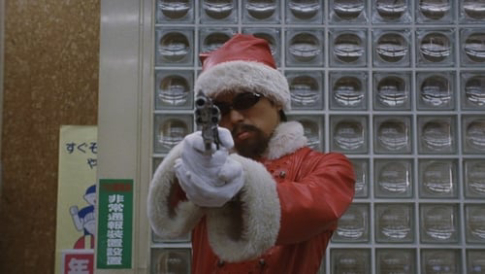
2: Love & Peace (Rabu & Pîsu, 2015)
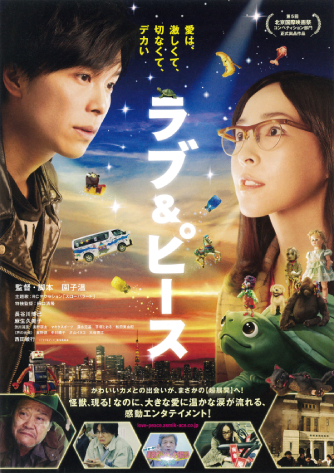
The beginning of this movie by Sion Sono (director of Tokyo Tribe and so many other brilliant movies) is sublime. We see a couple of middle aged men talking about the Olympic Games to be held in Tokyo, until they suddenly start to pick on a has-been rock star, Suzuki Ryoichi, who is not among them, making fun of him and humiliating him.
Suzuki watches the show in his tiny apartment, whimpering and cowering under his kotatsu, looking like a frightened turtle. He is an office employee now, bullied by his boss and his colleagues, except for one nerdy female employee who takes pity on him. He buys a small water-turtle he takes to his office, but after it is discovered and he gets humiliated once again, he flushes it in the toilet, heart-broken and ridden with guilt. It’s all extremely cruel and pitiful, but also hilariously funny.
The turtle ends up with a Gepetto-like old tinkerer who lives in the sewer, repairing toys thrown away by children who no longer take interest in them, and taking care of abandoned pets. He accidentally gives the turtle the magic power to fulfill wishes, and the turtle, who apparently bears no grudge for being tossed in the sewer, wishes for his former owner to become a famous rockstar again. And then thing get really rockin’.
This is not a Disney movie. Sion Sono is too cynical for that, although this movie has a strong moralistisc message. His special effects always seem to be purposely amateurish and cheap. The talking toys and animals are just dolls being manipulated by someone off-camera. The turtle is a real live animal at the beginning, but when he grows to gigantic proportions, like a friendly Godzilla, he looks like a cheap bath-toy.
But that only adds to the fun. Love & Peace is hilarious and endearing and it’s clear everybody involved in the movie is having a ball. It all takes place around Christmas and has a very Christmas-like plot-twist at the end.
The DVD/Blu-ray is available everywhere.
1: Survive Style 5+ (2005)
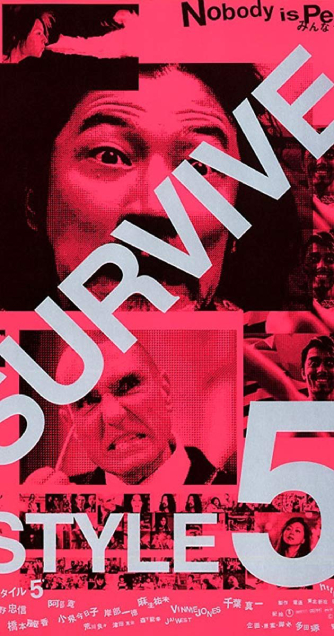
Not only is this my favorite Japanese Christmas movie, it’s one of my favorite films ever. Everybody goes on about how silly and absurd this movie and that it’s style over substance. This is due to the fact, I’m sure, that director Sekiguchi Gen is a succesful director of commercials, who knows how to make things look good.
But this does not mean that Survive Style 5+ is just strange for strangeness sake, that there’s no meaning to all this madness. People really need to learn to pay closer attention to the story that is told with the images, which Sekiguchi of course is an expert at. Survive Style 5+ looks breathtakingly gorgeous, but it is also a film about redemption, about loss and acceptance of that loss and breaking free from your self-imposed prison.
The film stars Asano Tadanobu, who is my favorite actor alive and who you probably know as Thor’s Asian-looking Asgardian friend. There are a bunch of other popular Japanese actors and one British star, the bullyish former soccer player Vinnie Jones. Jones is a hired killer arriving in Japan to murder a famous hypnotist and does so just after his victim hypnotised a sympathetic house father into believing he is a bird, who now has to stay a bird.
Meanwhile Asano Tadanobu repeatedly kills his wife who keeps returning from her anonymous grave in the woods to kick his ass in epic fights not unlike those between superheroes in a Marvel film.
The woman who ordered the murder of the hypnotist is his lover, who works in advertising and considers many crazy ideas for commercials. The house of the bird-father is burgled by three young excentrics coming to terms with their own sexuality and his family is slowly coming to terms with the fact their father is a bird in a human’s body now. Vinnie Jones goes around with his Japanese translator asking people the very disturbing question what their purpose is in life. Nobody’s answer satisfies him, until he meets Asano, who gives the right answer.
Christmas plays a very crucial part in this movie, more than in the four others in this list. It comes to posess the movie like a benign virus. It starts with a simple Merry Christmas sign in a coffee bar and soon blooms all over the place. When everything is covered with lights and stars and mistletoe and Christmas trees, and the sounds of The First Noel set in, all the protagonists come to their full potential.
And I find that very moving. And the young son of the bird-father has the best, most moving line of all. A message we should all take to heart.
I urge everyone to watch this movie and make that a Christmas tradition. Survive Style 5+ is very easy to find.
Christmas, Film Reviews, Japan, Peter Breedveld, 13.12.2019 @ 15:52


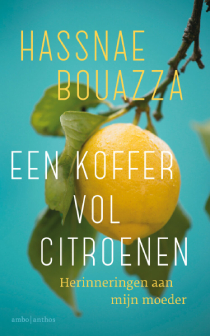
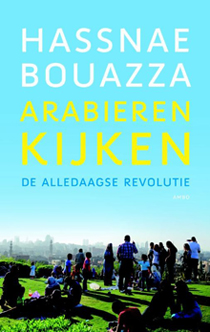


 RSS
RSS